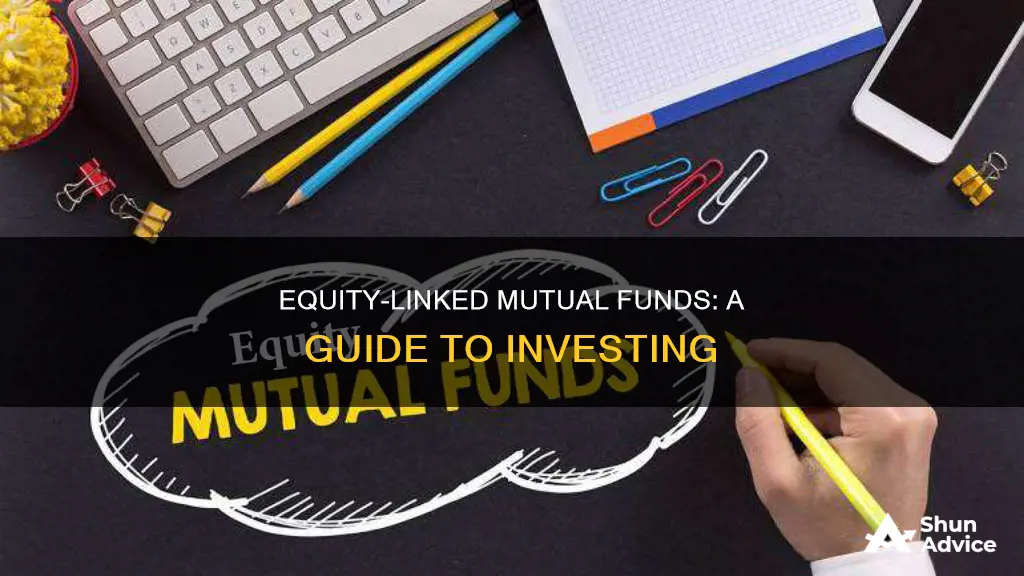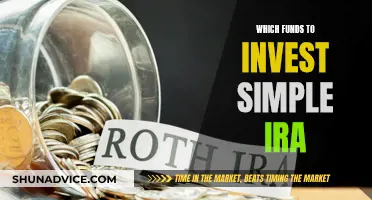
Equity Linked Savings Schemes (ELSS) are tax-saving mutual funds that invest in the stock market. They are a type of equity fund, which pools money from investors to buy a portfolio of stocks. ELSS funds are suitable for those who want to save tax and grow their wealth. They are also ideal for first-time investors as they offer a flavour of equity investing and mutual funds.
ELSS funds have a lock-in period of three years, offering the potential for high returns and tax savings. They are suitable for long-term investors.
| Characteristics | Values |
|---|---|
| Type of Investment Fund | Equity Fund |
| Investment Type | Stocks, also known as equity securities |
| Investment Objective | Returns for investors |
| Investment Style | Actively managed or passive funds |
| Investment Diversification | Diversified portfolio of stocks from many different companies |
| Management | Professionally managed by fund managers |
| Returns | Attractive long-term returns |
| Risk | High risk-return ratio |
| Tax Benefits | Yes |
| Lock-in Period | 3 years |
| Tax Saving | Up to Rs. 150,000 from annual taxable income |
| Minimum Investment | Rs.500 |
What You'll Learn

Know your investor personality
Knowing your investor personality is crucial before investing in equity-linked mutual funds. This involves assessing your financial goals, risk tolerance, and investment horizon.
First, you must understand your financial objectives. Are you saving for retirement, funding your child's education, or building long-term wealth? Different goals will require different investment strategies and risk levels.
Next, consider your risk tolerance. This refers to your ability and willingness to withstand market volatility and potential losses. Equity funds can be risky due to their focus on stocks, so you should carefully evaluate how much risk you are comfortable with.
Finally, determine your investment horizon, which is the length of time you plan to hold your investments before needing to access the funds. Equity funds are typically long-term investments, and short-term fluctuations may not impact your overall returns if you invest for the long term.
For example, if you are a young investor with a long investment horizon and a high-risk tolerance, you may opt for an actively managed small-cap growth fund. On the other hand, if you are nearing retirement and prefer a more conservative approach, a large-cap value fund might be more suitable.
It is important to remember that historical returns are not guaranteed, and past performance does not always predict future results. Therefore, conducting thorough research and due diligence is essential before investing in equity-linked mutual funds.
KiwiSaver Investment Funds: Where Does Your Money Go?
You may want to see also

Understand the tax benefits
Equity-linked mutual funds offer a range of tax benefits that can help investors reduce their tax liability and maximise their returns. Here are the key tax benefits to understand:
- Tax Deductions: Equity-linked savings schemes (ELSS) are a type of equity-linked mutual fund that offers tax deductions under Section 80C of the Income Tax Act, 1961. Investors can claim a deduction of up to Rs. 1.5 lakh per year on their investments in ELSS, resulting in potential tax savings of up to Rs. 46,800. This makes ELSS funds a popular choice for investors looking to save taxes.
- Lock-in Period: ELSS funds have a short lock-in period of just three years, which is the shortest among all tax-saving investments. This means that investors can access their money sooner compared to other tax-saving options.
- High Returns: ELSS funds offer the potential for high returns, even higher than traditional tax-saving instruments like fixed deposits (FDs) or public provident funds (PPFs). This is because ELSS funds invest primarily in equities, which have the potential for higher returns.
- Inflation-Beating Returns: ELSS funds are the only tax-saving investment option that offers the potential to beat inflation. This is because the returns of ELSS funds are market-linked and depend on the performance of the underlying equities in the portfolio.
- Tax Treatment of Capital Gains: The tax treatment of capital gains from ELSS funds is similar to that of other equity instruments. Short-term capital gains (STCG) are taxed at 15% if the holding period is less than 12 months. Long-term capital gains (LTCG) are taxed at 10% only if the gains exceed Rs. 1 lakh during the financial year.
- Dividend Taxation: Dividends received from ELSS funds are taxable as per the investor's tax slab. Dividends above Rs. 5,000 are also subject to a tax deducted at source (TDS) of 10%.
- Securities Transaction Tax (STT): When investing in equity-linked mutual funds, investors should be aware of the STT, which is levied by the government when buying or selling mutual fund units of an equity fund or a hybrid equity-oriented fund. The STT is currently set at 0.001%.
- Tax Efficiency: Equity-linked mutual funds are considered tax-efficient instruments compared to other investment options like fixed deposits. This is because the returns from mutual funds are subject to lower taxes, especially for long-term investments.
- Wealth Tax Exemption: According to the Wealth Tax Act, investments in mutual funds, including equity-linked mutual funds, are exempted from wealth tax. This provides an additional tax benefit to investors.
- Tax Benefits for Salaried Individuals: Salaried individuals who contribute to the Employees' Provident Fund (EPF) can benefit from investing in ELSS funds. ELSS funds offer higher returns and tax deductions under Section 80C, making them a more attractive option compared to other tax-saving instruments like unit-linked insurance plans (ULIPs) or the National Pension System (NPS).
- Tax Benefits for First-Time Investors: For new investors, ELSS funds offer not only tax benefits but also exposure to equity investing and mutual funds. While equity investments carry a higher risk, the risk is generally lower over the long term (more than five years).
Overall, understanding the tax benefits of equity-linked mutual funds is crucial for investors looking to maximise their returns and minimise their tax liability. These funds offer a range of tax advantages, including tax deductions, high returns, and inflation-beating potential, making them a popular choice for long-term investors.
The S&P Fund: A Guide to Investing Wisely
You may want to see also

Be aware of the risks
Equity-linked mutual funds are a great way to save taxes and grow your wealth. However, it is important to be aware of the risks involved before investing. Here are some key points to consider:
Risk of Losing Money
Equity investments carry a degree of risk, and investors can potentially lose their principal investment. Equity shares are volatile and prone to price fluctuations, which can occur due to various microeconomic factors such as changes in government policies, economic cycles, interest rates, or political events. These factors can impact stock prices and lead to either an increase or decrease in share value. It is important to assess your risk tolerance and financial goals before investing.
Liquidity Risk
Mutual funds with long-term and rigid lock-in periods, such as ELSS (Equity Linked Savings Scheme), often come with liquidity risk. Investors may find it challenging to redeem their investments without incurring losses during the lock-in period. Lack of buyers in the market can also make it difficult to redeem investments when needed. Therefore, it is essential to consider the liquidity risk when investing in mutual funds with lock-in periods.
Interest Rate Risk
Changes in interest rates can impact the price of securities. If interest rates increase during the investment period, it may result in a reduction in the price of securities. This can lead to a loss for investors as they may not get back their initial investment. On the other hand, if interest rates decrease, investors may have the opportunity to sell their investments at a price above the invested amount.
Credit Risk
Credit risk arises when the issuer of the scheme fails to pay the promised interest. In debt funds, fund managers typically include investment-grade securities with high credit ratings. However, to enhance returns, they may sometimes include lower credit-rated securities, increasing the risk of non-payment. It is important to assess the credit ratings of the portfolio composition before investing in debt funds.
Inflation Risk
Inflation risk refers to the possibility of losing purchasing power due to rising inflation rates. If the returns on investments fail to keep up with the inflation rate, investors may not see real growth in their capital. For example, if the returns are 5% and the inflation rate is 3%, the investor is left with only a 2% real return.
Concentration Risk
Concentrating a significant amount of your investment in one particular scheme or sector is risky. While profits can be high, losses can also be substantial. Diversifying your portfolio across different schemes and sectors can help mitigate this risk. A diverse portfolio lowers the overall risk and provides a better risk-reward ratio.
Market Risk
Market risk, also known as systematic risk, is the possibility of losses due to the poor performance of the market. Factors such as natural disasters, inflation, recession, political unrest, and interest rate fluctuations can impact the market. Diversification may not help in these scenarios, and investors may need to wait for market conditions to improve.
Best Mutual Funds for Tax Savings: Where to Invest?
You may want to see also

Compare fund performance
When comparing the performance of equity-linked mutual funds, there are several key factors to consider.
Firstly, it is important to assess the fund's historical performance and track record. This includes evaluating its returns over various periods, volatility measures such as standard deviation or beta, and risk-adjusted returns. It is worth noting that past performance does not guarantee future results, but it can provide valuable insights into the fund's management style and decision-making process.
Secondly, the expense ratio, or the annual fee charged by the fund, should be taken into account. Higher expense ratios can significantly impact long-term returns, so it is essential to compare fees with other funds in the same category.
Thirdly, consider the fund's investment strategy and management style. Actively managed funds, for example, tend to have higher fees as they involve portfolio managers actively researching, analyzing, and selecting stocks. On the other hand, passively managed funds, such as index funds, aim to replicate the performance of a specific market index and generally have lower fees.
Additionally, the fund's investment objectives, risk tolerance, and time horizon should align with your own financial goals and risk appetite. For instance, a young investor with a long time horizon and a high-risk tolerance may opt for a high-risk growth fund, while someone nearing retirement may prefer a more conservative value fund.
Other factors to consider include the fund's prospectus, annual and quarterly reports, the fund manager's competence and experience, and the fund's performance relative to its peers and the benchmark. By carefully evaluating these factors, you can make a more informed decision when comparing the performance of equity-linked mutual funds.
Mortgage Investment Strategies to Boost College Funds
You may want to see also

Consider the fund manager
When investing in equity-linked mutual funds, it is important to consider the fund manager. The fund manager plays a crucial role in managing your investments and ensuring they align with your financial goals. Here are some key factors to consider when evaluating the fund manager:
Qualifications and Experience
Look for a fund manager with extensive knowledge and experience in the field. Most fund managers have advanced educational qualifications, such as a Chartered Financial Analyst (CFA) designation, and relevant professional licenses and credentials. They should also possess strong business, mathematical, and interpersonal skills to effectively manage a team of analysts and make informed investment decisions.
Investment Style and Strategy
Before investing, review the fund manager's investment style to ensure it aligns with your own. Fund managers can be active or passive. Active fund managers aim to outperform the market and their peers by actively selecting and managing investments. They study market trends, analyse economic data, and make proactive investment decisions. Passive fund managers, on the other hand, take a more hands-off approach, mirroring a specific market index or benchmark.
Track Record and Performance
Evaluate the fund manager's track record and the fund's performance history. Look for consistent, long-term fund performance that matches the manager's tenure. Analyse how the fund has performed compared to its peers and relevant benchmark indexes. While past performance doesn't guarantee future results, a strong and consistent track record demonstrates the manager's skill and ability.
Competence and Expertise
The fund manager should be competent and experienced in selecting the right stocks and creating a robust investment portfolio. They should have a deep understanding of the market and the ability to conduct in-depth research and analysis. The manager should also be able to adapt their investment strategies based on market trends, economic conditions, and the fund's goals.
Fund House Performance
In addition to evaluating the fund manager, consider the performance of the fund house or investment firm they represent. Look for fund houses that have consistently delivered strong returns over the long term, typically at least five to ten years. This indicates a stable and successful investment approach.
Remember, the fund manager plays a pivotal role in the success of your investments. By considering their qualifications, investment style, track record, and competence, you can make a more informed decision about investing in equity-linked mutual funds.
Contingency Fund Investment: Where to Place Your Safety Net?
You may want to see also
Frequently asked questions
An equity-linked mutual fund, or equity fund, is a type of investment fund that pools money from multiple investors to buy a portfolio of stocks. These funds are managed by professionals and are known for their diversification, with most funds investing in 40-50 stocks. Equity funds are suitable for investors with a high-risk appetite and a long-term investment horizon.
The fund manager of an equity-linked mutual fund decides which stocks to invest in, with the goal of maximising returns. The stocks are chosen based on extensive market research and analysis of various factors such as company profitability and performance. The fund manager continuously monitors the performance of the chosen companies and makes adjustments to the portfolio as needed.
Equity-linked mutual funds offer several benefits, including diversification, professional management, and the potential for attractive long-term returns. These funds are suitable for investors who want to build wealth over time and are willing to take on the higher risk associated with stock market investments.
Investing in equity-linked mutual funds typically involves the following steps: determining your investment goals, risk tolerance, and time horizon; researching and analysing potential funds; opening an investment account; and buying shares of the chosen fund. It is important to consider the fees associated with these funds, as they can significantly impact your overall returns.







